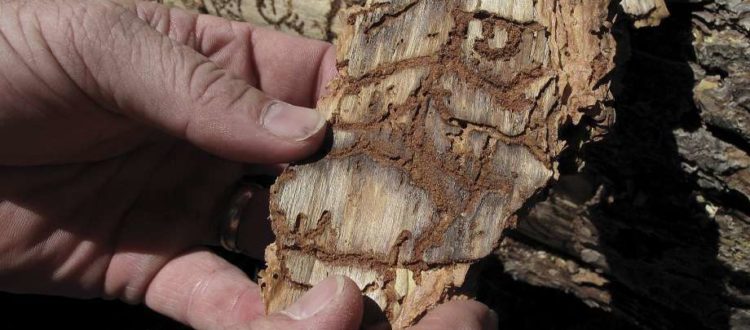Another dry year on California’s books as ‘drought continues’
Published on October 5th, 2016
In this June 6, 2016 photo, Division Chief Jim McDougald of the California Department of Forestry and Fire Protection holds a piece of tree bark showing burrowing marks from a bark beetle infestation near Cressman, Calif. California's drought and the bark beetle epidemic have caused the largest die-off of Sierra Nevada forests in modern history, raising fears that trees could come crashing down on people or fuel catastrophic wildfires, devastating mountain communities and choking the sky with smoke.
By Kurtis Alexander
October 3, 2016
SFGATE
October is the time for optimism about water in California.
The forecasts start calling for rain as the coming winter offers hope of relief for the state’s thirsty rivers and reservoirs. Just this weekend, parts of Northern California saw up to three quarters of an inch of rain, while the first big snow shut down Highway 120 in Yosemite.
Hydrologically speaking, Oct. 1 also marked the official start of the state water year. But as much as the milestone brought the prospect of drought-busting storms ahead, it highlighted the grim reality of the past 12 months.
State water officials last week described the 2016 water year, running from Oct. 1, 2015 to Sept. 30, as disappointingly “dry” — the fifth year of “meager precipitation” helping fuel the historic drought.
“Without hesitation, the assessment is that the drought continues and we continue to encourage conservation,” said Doug Carlson, a spokesman for the state Department of Water Resources.
While the northern part of the state, where most of California’s water supply comes from, saw above-average precipitation during the water year — about 116 percent — it wasn’t enough to make up for previous deficits, nor help the much drier Southland.
Northern California remains about 15 percent below average for precipitation over the past five years, according to state data. Southern California is more than 50 percent below average.
Making matters worse, warmer-than-normal temperatures this past year meant more rain than snow, which doesn’t bode well for water supplies. Snow in the Sierra serves as a natural reservoir that, if sufficiently built up, stretches through the summer when man-made reservoirs run dry.
It’s important to note that California’s hundreds of water agencies rely on different supply portfolios, putting each in distinctly different positions at the end of the water year. Most Bay Area suppliers have said they can weather at least three more dry years.
State regulators, meanwhile, have dropped mandatory conservation rules and are allowing local communities to determine whether they need to threaten sanctions.
The prognosis for the coming water year remains far from certain. The development of La Niña conditions in the Pacific Ocean over the summer recently ceased, giving forecasters little clue on whether winter will be wet or dry.





